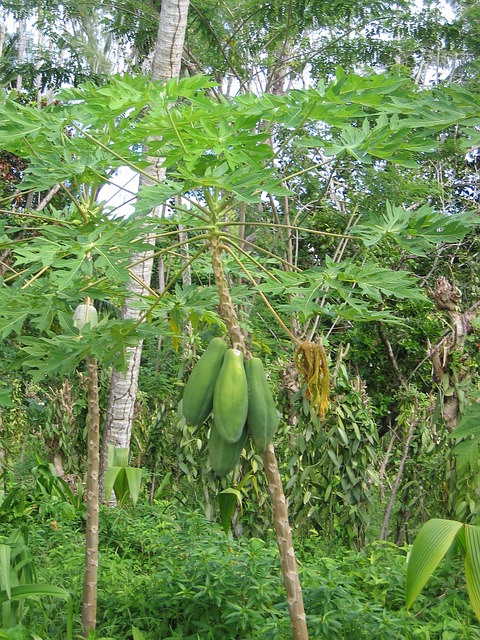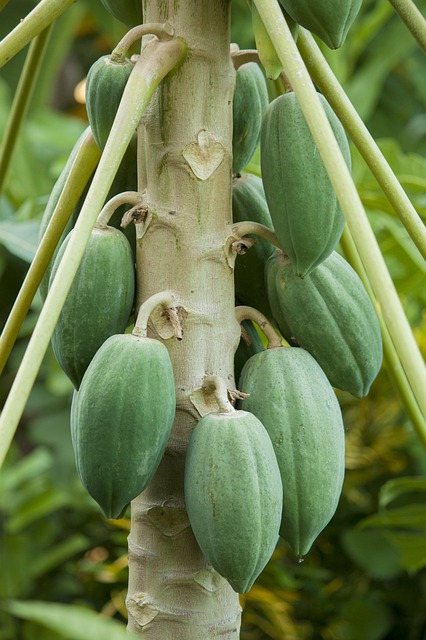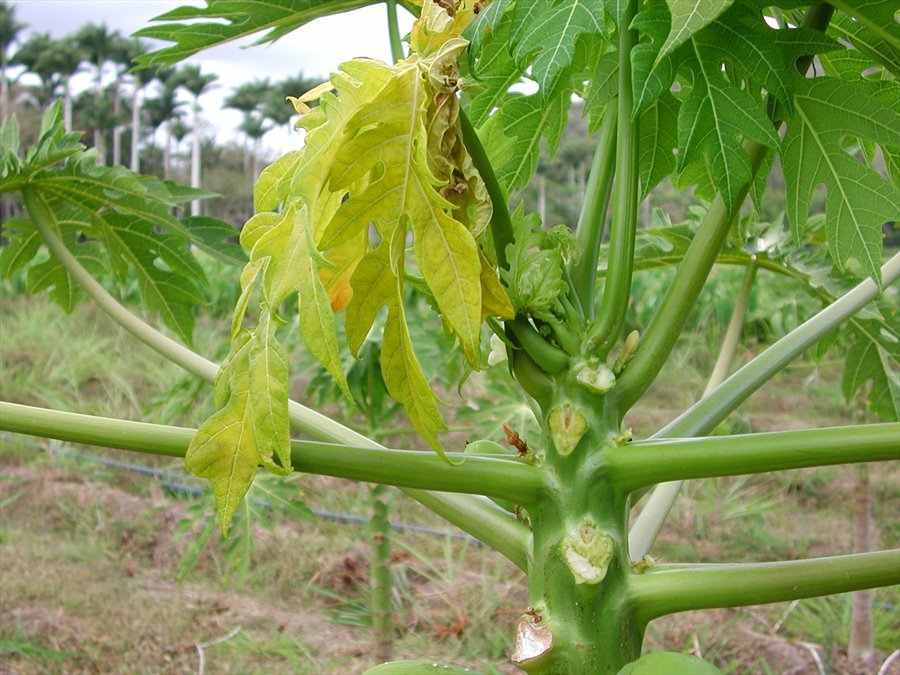Papaya, also known as Carica papaya is herbaceous perennial. It belongs to family caricaceae. They are known to have originated in Caribbean in Central America. Papaya plants are generally grown in tropical or subtropical regions. They are native to Mexico and Southern America. In the USA, they are grown in Florida, Texas,southern California and hawaii. Based on their region of growth, the colour of this fruit varies.
The papaya plant bears edible fruit called papaya. The plant is treelike and usually unbranched. Stem of the papaya plant is hollow along with the petioles. Leaves are palmately lobed and arranged spirally on the top.height of plant is 2-10 m and its life span is around 25 years. This plant is found as males, females and hermaphrodites too.
Papaya is a tropical plant that bears pear shaped or melon like fruits. It is a little difficult to grow it because of its sensitive nature. Also, they cannot bear too cold temperatures, high winds and shades. Plus, papaya plants are very susceptible to diseases. Shortage of water, disease and attack by nematodes can result in wilting of leaves in papaya plants.
Male plants usually bear many flowers while female flowers bear either clusters of solitary flowers or very few flowers. Fruit of papaya is edible and is consumed by masses. It is a fleshy berry which has smooth skin on it. Skin of papaya is green and turns red, yellow or orange as it matures. Flesh of fruit is succulent and thick. Its colours vary from yellow,red to orange. Also, it contains numerous blackwrinkled seeds in it.
Basics of Papaya Plant
Plantation should be replaced every 3 years to ensure productivity to be maximum. Another name of papaya is pawpaw.

They can be eaten fresh. Along with this, people make jams, jellies, candies, and juice of papaya too. Young leaves and green fruit of papaya can be cooked and consumed as a vegetable.
Growth of papaya
papaya is a tropical plant. It grows very well in temperatures ranging from 21C to 33C. They require rainfall of at least 4 inches per month for proper growth. However, proper irrigation can also ensure undisturbed growth of papaya in dry areas. Avoid growing papaya plants in areas with risk of floods or waterlogged soils. They are also very sensitive to high winds and can easily get toppled in winds. Therefore, avoid their growth in windy areas.
Seeds can be planted out in soil and areas which receive good sunlight. But they can also grow well in containers at the start. They are grown in sterilized soils in nursery to keep diseases at bay. You can sow 3-4 seeds in one container.
Once they reach a height of 20 cm, they are ready to be planted outside. They generally grow well on hills or ridges. This is because of these places aid drainage. In addition to this, space them 2-3 m apart to ensure proper development.
Care and maintenance of Papaya
First of all seeds of papaya plants must be sown properly in well-drained soil. Proper Water supply must be ensured. Proper watering is required to grow papaya successfully. If water is not provided in the required amount that results into dropping of leaves, fruits, or flowers. Small fruits of papaya have a very small sugar content and cannot be consumed raw. In later stages, the supply of water can be reduced.
They are highly susceptible to diseases and weeds. Keep the area clean and weed free.
Mulch can be used to suppress weeds around papaya plants. Moreover, mulch has added benefits and retains moisture in soil. Regular use of fertilizer is advised to provide proper nutrition to plants. Giving required nutrients to plants helps is production of sweet and healthy fruits.
Commercial plants can be fertilized for about 2-4 times in a year. While, plants grown for personal use in gardens can be fertilized with ¼ cup of fertilizer every fortnight. When plants grow and reach the age of 7-8 months, fertilize them with 1-2 lbs of fertilizer every couple of months.
Also, these plants do not require pruning. But you can remove dead leaves from the plant without worrying.
Harvesting of Papaya
Harvesting takes around 22- 26 weeks for plants to mature. However, fruits can be picked anytime when ⅕ of fruit surface turns yellow. In addition to this, sweetness of fruit increases with time. Therefore, if you wish your fruits to have high sugar content, pick them a little later than usual. For removal of fruits, they can be either twisted or snapped. You can also use a knife to remove them.
Common diseases and pests- papaya plants are very susceptible to diseases. There are numerous microorganisms and pests that can affect these plants badly. Some of the common diseases and pests of papaya plants are mentioned below.
- Anthracnose and charcoal spot- This disease is caused by fungi named Colletotrichum gloeosporioides. It causes light brown margins in circular lesions on plants. Also, small water soaked lesions are found on plants. Fungicide can be used to control the disease.
- Black rot- Mycosphaerella caricae is responsible for this disease. It causes black sunken rot on young fruits. Young fruits start withering and dropping from the plant. This disease can be controlled by proper use of fungicide. Alos, fruits can be dipped in 48C hot water for 20 min to kill the fungus.
- Black spot- This is also a fungal disease. It leads to formation of circular water soaked lesions. Centre of lesions becomes bleached in later stages. It can be controlled with fungicide.
- Powdery mildew- Infection of all tree parts is observed in this disease. White mycelial growth occurs on the upper leaf surface. Infected area on the plant becomes light green. For getting rid of infection, avoid sprinkler irrigation systems. Also, remove the infected part to avoid further spread. Fungicides can be applied in case of severity.
- Pest called as Papaya mealybug feeds on papaya plant and destroys it. It also causes plant stunting, early leaf and fruit drop. Lady beetles can be used as a natural enemy against mealybug. However, usage of chemicals can kill lady beetles and result in an outbreak of mealybug.
Cause Of Wilting Leaves In Papaya Plant
The Main reason behind wilting of leaves is insufficient watering, attack of nematodes and diseases.
Here are a few diseases mentioned that can result in wilting of papaya leaves.
- Apical necrosis- this is a viral infection. In this disease,papaya leaves start curling downwards and wilt. Leaf margins turn brown and young leaves become small and have shortened petioles. As the name suggests, the disease basically begins at the top and infects other plant eventually. Gradually, it kills whole plant. Organism responsible for this deadly disease is still unknown and so is the cure. Diseased plant must be isolated to protect other plants from dying.
- Phytophthora blight- This disease is caused by fungi and is extremely destructive. It leads to the death of infected plant. Root, stem and fruit of plants begin to rot in such conditions. Rapid wilting is observed and the plant dies after that. Water soaked lesions are also observed on the stem. On fruits water soaked lesions appear with white fungal growth. Further, fruit shrivels and drops. In this manner, fungus comes in contact with ground and infects roots too. This fungus is spread by wind too.
Fungicide for this disease is available but it requires good cultivation practice too. Ensure good draining soil to treat this disease. Remove destroyed or fallen fruits as fast as possible. Remove any afrucan snails from the planting site as they spread this disease.
- Nematodes – these organisms are microscopic worms that attack and lead to the formation of galls in the roots of papaya plants. Galls interfere with the ability of plants to take in water and nutrients. Therefore,this results in wilting of leaves, stunting, yellowing and reduced crop yield and death of plants eventually.
These organisms can be present in any type of soil. Before planting,make sure to turn soil several times and leave it so that nematodes are exposed to sunlight.this practice results in death of nematodes.
Crop rotation also helps in handling the disease. Remove Plant debris after harvesting. To add to this, usage of resistant varieties like cassava, taro and heatmaster of tomato can be helpful
- Bacterial canker and decline- Angular water soaked lesions are seen on leaves. Wilting of leaves also occurs in this disease. Water soaked lesions and cankers on the stem are observed.
Why are my papaya leaves turning yellow
The reason behind yellowing leaves infection by lethal virus. The name of this virus is Papaya Lethal Yellowing Virus (PYLV). It occurs only in Northeastern Brazil.
It results in progressive leaf yellowing and growth of greenish circular spots. The leaves wilt after becoming yellow and die. Whole plant dies eventually due to the infection.
Must Read: Why are my Strawberry Leaves Turning Red
Virus that infects plants and causes this disease generally belongs to the genus Sobemovirus. Papaya plant species that are generally infected are C.papaya, Jacaratia heterophylla, V. monicca, J.spinosa, etc.
This disease can be managed and avoided by using virus free certified plantings. Further, plants that are infected must be isolated. Usage of disinfectants to clean agricultural equipment is advised.
How to identify male and female plant seeds?
It is not possible to identify the gender of papaya seeds from naked eyes.DNA analysis is required to figure out the gender of seed. However, you identify male and female seeds once they turn into seedlings.
Male seedlings produce single straight root but female seedlings produce 2 or more branched rootlets.
Be careful while checking the gender of the seedling and avoid root damage. Just wait for plants to develop 1 or 2 true leaves and then check their rootlets.
How to pollinate papaya flowers?
One way of pollinating papaya flowers is hand pollination.

Pollination generally occurs through wind or insects.
Hermaphrodite plants have both male and female reproductive organs present in them. They do not require pollen from other plants to pollinate themselves. In other words, papaya plants undergo self pollination.
Why is my papaya tree not fruiting?
Papaya plants in home gardens fail to bear fruits sometimes. A few other times, they bear fruits but drop them as time passes. This situation can occur because of wrong pollination. Sometimes, male flowers get pollinated. But due to lack of ovary it does not bear any fruits. In rare conditions, male flowers start bearing fruit too but that fruit does not mature and drops off at a young stage.
If a tree is a female, it requires pollen to bearfruits.in case, the female plant does not receive pollen then it does not bear any fruits. Pistils of such plants start turning brown and non functional after some time.

In few cases, trees become summer sterile bisexual. Though they have both reproductive plant parts but hot weather in summer can lead to infertility. However, in cool months trees begin to function normally.
Insufficient water supply can result in a non- fruiting condition in plants. If a proper amount of water is not provided then plants cease to bear flowers and therefore there is no fruit formation too.
Excessive dryness in plants can lead to death eventually.
If the tree looks perfectly fine from outside and a proper water supply is ensured with good soil drainage and still there are no fruits. This can be a sign that the tree is starving to death. Lack of nutrients is the cause of this problem.
Provide proper nutrition to plant to get rid of problem.
Pests and diseases can also lead to no fruiting in papaya plants. When the natural functioning of plants is disturbed, they fail to fruit. Diseases like mildew and root diseases lead to non fruiting.
There are various conditions that can lead to problems and death in papaya plants. But the cure and treatment is also known to mankind. You can deal with diseases and make your plants healthy. Papaya is a herbaceous perennial and a little care of it will bring sweet fruits to you.

